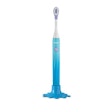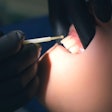
Both original-flavor and sour candies are tough on tooth enamel, but the sour variety has much greater erosive potential, according to a new study in the Journal of the American Dental Association.
"To my knowledge, there have not been research investigations that describe the erosion potential of acidic hard candies -- sour or otherwise -- marketed in the U.S.," study author Teresa Marshall, Ph.D., an associate professor at the University of Iowa College of Dentistry, told DrBicuspid.com. "There have been anecdotal reports and hypotheses that such candies can cause erosion, but this study presents the science to support such hypotheses."
— Teresa Marshall, Ph.D.
Marshall and colleagues used an in vitro design to identify the erosion potential of original-flavor and sour candy slurries when exposed to extracted human teeth.
They looked at four brands of sour candies that had original-flavor counterparts: Jolly Ranchers, Life Savers, Mike and Ikes, and Twizzlers.
The researchers dissolved the candies in artificial saliva or water, and compared the pHs and titratable acidities of the original-flavor candies with those of the sour candies.
Using 80 uncavitated premolars and molars from a pooled supply, the researchers submerged five teeth per slurry for a total of 25 hours. They then compared lesion depths in enamel surfaces for original-flavor versus sour candies dissolved in either artificial saliva or water.
Marshall and her team noted that sour candies had lower pHs and higher titratable acidities in artificial saliva than the original-flavor candies. In water, only sour Twizzlers had a pH lower than that of the original-flavor candy; all sour candies had titratable acidities higher than those of the original-flavor candies.
"Compared with water, the artificial saliva solvent was associated with higher pHs and lower titratable acidities for original-flavor candies but not for sour candies," the authors noted (JADA, July 2009, Vol. 140:7, pp. 906-913).
For the artificial saliva solvent, enamel lesion depths were significantly greater after exposure to sour candies than after exposure to original-flavor candies for Jolly Ranchers, Life Savers, and Mike and Ike, but the difference was not statistically significant for Twizzlers, according to the researchers.
"Our results are consistent with the hypothesis that sour candies are more erosive than their original-flavor counterparts, particularly in an artificial saliva solvent," the authors wrote. "Artificial saliva as a solvent was more protective against the erosive effects of original-flavor candies than it was against the erosive effects of sour candies."
Sour candies have lower pHs than their regular counterparts, presumably due to higher acidic ingredient concentrations, Marshall said.
This study can increase dentists' awareness of the potential for sour candies to contribute to erosion, and help them identify the etiology of erosion in patients who are difficult to diagnose, giving them another dietary product to consider.
Dental caries and erosion likely result from an interplay of behaviors and food and beverage composition, Marshall added.
"Almost any carbohydrate or acid-containing food/beverage product consumed in an ill-advised manner can increase risk of caries and erosion," she said. "However, the same products can also be consumed safely. The task of the dentist is to provide anticipatory guidance that is realistic and doable."
Dentists should use the study's findings to help guide patients to consume these candies in a "healthy" fashion -- particularly those patients with dry mouth, she concluded.
Copyright © 2009 DrBicuspid.com



















